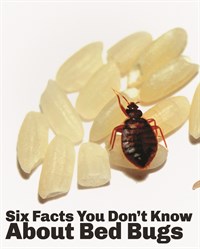
Trebol-a/Flickr
The heat wave currently gripping the globe is resulting in a myriad of less than welcome side effects, including withering corn crops in Europe, glacial flooding in Greenland to even death in the Midwest. There's more: According to the National Pest Management Association, the soaring, dry temperatures are ideal for America to see a boom in pest populations.
“Insects are cold-blooded, which means that their body temperatures are regulated by the temperature of their environment,” said Missy Henriksen, the vice president of public affairs for the NPMA. “In cold weather, insects’ internal temperatures drop, causing them to slow down. But in warm weather, they become more active. Larvae grow at a faster rate, reproduction cycles speed up and they move faster.“
Which means perfect conditions for a host of pests including fleas, ticks, termites, mosquitoes, brown recluse and black widow spiders and scorpions to flourish in the coming weeks. What’s worse, the hot, dry temperatures will eventually drive those pests to seek out moisture and cool places to dwell — like homes.
“Homeowners will likely encounter more pests in their homes than usual,” said Henriksen. “Even areas of the country that are receiving rain aren’t in the clear, as standing rain water breeds mosquitoes, which can spread West Nile virus.”
According to USA Today, there have been forty-seven reports of West Nile Virus in America this year, including one fatality in Texas.
The NPMA recommends taking a series of precautions to ward off the pesky bugs, like wearing insect repellant that contains DEET or picaridin when outdoors, and eliminating any standing water around your home. They also want to remind pet owners not to overlook their animals.
As always Servall Termite & Pest Control is here for all of your pest control and home repair needs. Contact us today at one of our four convenient locations or visit http://www.servallpestcontrol.com!
Source: http://www.scpr.org/blogs/environment/2012/07/25/9145/us-heat-wave-could-lead-pest-population-explosion/


.jpg)